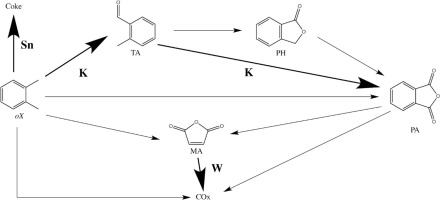Catalysis Today ( IF 5.2 ) Pub Date : 2018-04-12 , DOI: 10.1016/j.cattod.2018.04.025 P. Eversfield , T. Lange , M. Hunger , E. Klemm

|
VOx monolayer on TiO2 catalysts have been prepared by grafting and subsequently promoted with tungsten, tin, and potassium by impregnation. The samples have been characterized through N2 physisorption at 77 K, PXRD, Raman spectroscopy, H2-TPR, and 1H Solid State NMR spectroscopy with NH3 as probe molecule. Catalytic measurements have been performed in an isothermal fixed bed reactor at 350 °C with 1.5 vol.% o-xylene in air. Space velocities were varied to get selectivity-conversion-diagrams for CO2 and maleic anhydride as side products as well as phtalic anhydride, toluyl aldehyde and phthalide as value products. The selectivity-conversion diagrams of the unpromoted sample clearly indicate a direct pathway from o-xylene and/or toluylaldehyde towards phthalic anhydride. Tungsten, tin and potassium promoted samples were compared with unpromoted samples. It was found that optimum accessibility and acidity of the promoted VOx monolayer can explain the observed promoter effects. Tungsten as promoter decreases MA selectivities and increases PA selectivities at an optimum loading of 0.12 wt.% WO3. Tin was detrimental at all loadings because acidities seem to be too high causing too strong adsorption and condensation reactions of o-xylene. With potassium as promoter lowest acidities and highest V accessibilities were reached which correlates with the increase of activity and PA selectivity. In contrast to potassium, tungsten and tin move significantly into the TiO2 support during calcination which was proven by XPS measurements on sputtered probes. This might explain why potassium acts more efficiently as promoter already at low promoter levels.
中文翻译:

邻二甲苯到对钨,锡邻苯二甲酸酐的选择性氧化,并促进钾VO X上的TiO 2单层催化剂
TiO 2催化剂上的VO x单层是通过接枝制备的,随后通过浸渍用钨,锡和钾促进。通过在77 K下进行N 2物理吸附,PXRD,拉曼光谱,H 2 -TPR和以NH 3为探针分子的1 H固态NMR光谱对样品进行了表征。催化测量是在等温固定床反应器中于350°C,空气中有1.5%(体积)邻二甲苯进行的。改变空间速度以获得CO 2的选择性转化图和顺丁烯二酸酐为副产物,以及邻苯二甲酸酐,甲苯甲醛和邻苯二甲酸酯为有价值的产品。未促进的样品的选择性转化图清楚地表明了从邻二甲苯和/或甲苯醛到邻苯二甲酸酐的直接途径。将钨,锡和钾促进的样品与未促进的样品进行比较。发现促进的VO x单层的最佳可及性和酸度可以解释观察到的启动子效应。钨作为助催化剂,在0.12 wt。%WO 3的最佳负载量下降低了MA的选择性并提高了PA的选择性。锡在所有负载下都是有害的,因为酸度似乎太高,导致邻二甲苯的吸附和缩合反应过强。用钾作为促进剂时,达到最低的酸度和最高的V可利用性,这与活性和PA选择性的增加有关。与钾相反,在煅烧过程中,钨和锡会显着移动到TiO 2载体中,这已通过溅射探针上的XPS测量证明。这可以解释为什么钾已经在低启动子水平下更有效地作为启动子起作用。











































 京公网安备 11010802027423号
京公网安备 11010802027423号